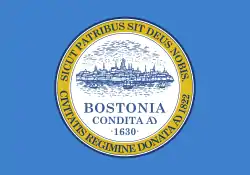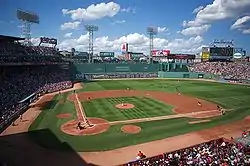Huntington Avenue Grounds
Huntington Avenue American League Baseball Grounds is the full name of the baseball stadium that formerly stood in Boston, Massachusetts, and was the first home field for the Boston Red Sox (known informally as the 'Boston Americans' until 1908) from 1901–1911. The stadium, built for $35,000 (equivalent to $1.08 million in 2019), was located on what is now Northeastern University, at the time across the New York, New Haven and Hartford Railroad tracks from the South End Grounds, home of the Boston Braves.
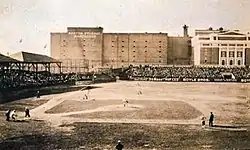
Huntington Avenue Grounds | |
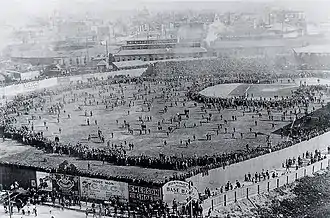 | |
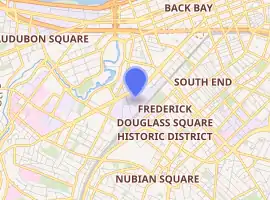
| |
| Location | Boston, Massachusetts |
|---|---|
| Coordinates | 42°20′20.3″N 71°5′20.3″W |
| Owner | Boston Red Sox |
| Capacity | 11,500 |
| Field size | Left Field – 350 ft Left-Center – 440 ft Center Field – 530 ft (1901), 635 ft (1908) Right Field – 280 ft (1901), 320 ft (1908) Backstop – 60 ft |
| Construction | |
| Broke ground | March 9, 1901 |
| Opened | May 8, 1901 |
| Closed | After 1911 season |
| Demolished | 1912 |
| Tenants | |
| Boston Red Sox (MLB) (1901–1911) | |
The stadium was the site of the first World Series game between the modern American and National Leagues in 1903, and also saw the first perfect game in the modern era, thrown by Cy Young on May 5, 1904. The playing field was built on a former circus lot and was extremely large by modern standards-530 feet (160 m) to center field, later expanded to 635 feet (194 m) in 1908. It had many quirks not seen in modern baseball stadiums, including patches of sand in the outfield where grass would not grow, and a tool shed in deep center field that was in play.
The Huntington Avenue Grounds was demolished after the Red Sox left at the beginning of the 1912 season to play at Fenway Park. The Cabot Center, an indoor athletic venue belonging to Northeastern University, has stood on the Huntington Grounds' footprint since 1954. A plaque and a statue of Cy Young were erected in 1993 where the pitchers mound used to be, commemorating the history of this ballpark in what is now called World Series Way. Meanwhile, a plaque on the side of the Cabot Center (1956) marks the former location of the left field foul pole.
The Cabot facility itself is barely over a quarter mile away to the southwest from another, still-standing Boston area sports facility of that era, Matthews Arena (built in 1910), the original home of the NHL's Boston Bruins when they started play in 1924.
References
- Ballpark Digest Article on Huntington Avenue Baseball Grounds
- Huntington Avenue Baseball Grounds at Baseball Almanac
- Info at Ballparks.com
- See Huntington family
| Preceded by first stadium |
Home of the Boston Red Sox 1901–1911 |
Succeeded by Fenway Park |
